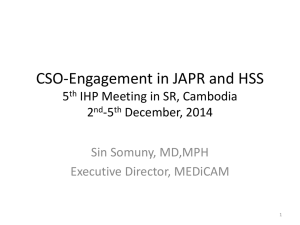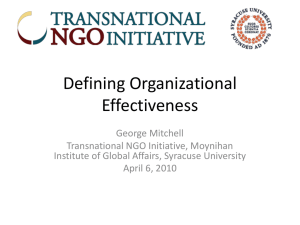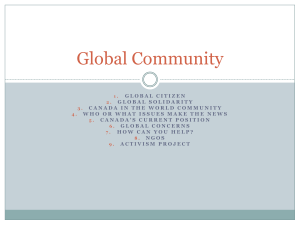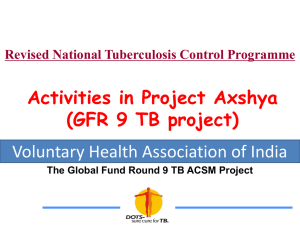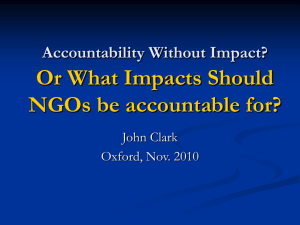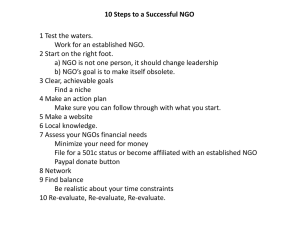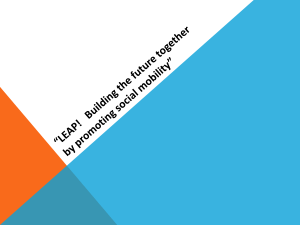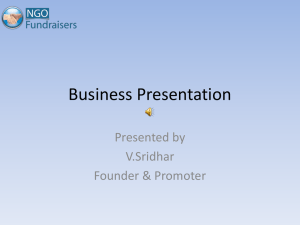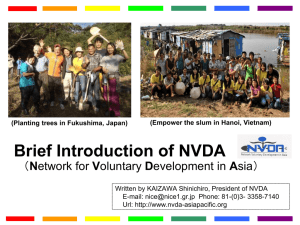Role of NGOs in NRLM Final
advertisement
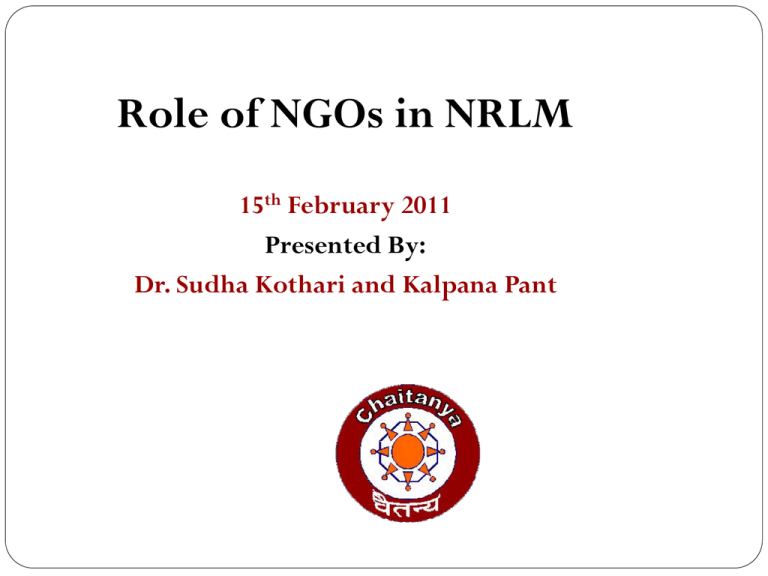
Role of NGOs in NRLM 15th February 2011 Presented By: Dr. Sudha Kothari and Kalpana Pant 1 Chaitanya – Empowering Women and Youth One of the earliest institutions to promote poor women’s financial institution Promoted first SHG federation in Maharashtra – in 1991 – has been rated by M-CRIL and received support from NABARD, SIDBI and commercial Banks Initiated Jankar programme – community resource persons for SHG, federations, livelihood and legal counseling 2 Why NGOs? To identify the needs, opportunities/risks and perceptions of the community To monitor and evaluate the program effectively To innovate and institutionalize community-based institutions To develop ownership among the community for continued involvement 3 Why NGOs? To facilitate convergence of resources To reduce cost, and ensure sustained financial contribution to run the programme To increase effectiveness of the programme by using local knowledge and ensure culture sensitivity To empower the community, facilitate community involvement in decision making 4 Role of NGOs in Development EXECUTION - Piloting, innovation Designing need based programmes Identification and reaching the poorest of the poor Identification of community leaders Social mobilisation, awareness building Local institution building 5 Role of NGOs Contd… Research and Advocacy Watchdog Building pressure for policy changes (RTI) Research based advocacy Capacity Building Transfer of technology Facilitating Convergence Exposure Creating learning platforms 6 Role of NGO vis a vis Government agencies Complementarity between government and NGOs: NGO researches and pilots, Govt replicates (SHG) Govt. plans, NGOs execute (Jal Swarajya) Government plans and executes, NGO monitors or involved in capacity building (NRHM) NGO raises concerns, Government amends policies/programs (Forest Bill) 7 Role of NGOs under NRLM Role of NGOs in NRLM - Initial remarks Fluidity even at the national level – scope to determine/ evolve the role Everyone to participate to generate thoughts ideas to increase complementarity and evolve framework for useful partnership. 9 Strategies in NRLM Community Mobilization to promote community owned institutions Capacity Building and training Cadre Building through Community Resource Persons ( CRPs) Convergence –public private partnerships Monitoring and Evaluation Recruitment of trained staff from NGOs 10 Broader framework NGOs are important stakeholders – both in planning, implementation as well as monitoring of the programme Need investment from the government to facilitate better partnership Develop good institutional mechanism and right structure to work with NGOs 11 Challenges Selection of NGOs – not based on merit or determined by transparent criteria, often under political pressure Lack of coordination – resulting in delayed implementation Passing the buck –shifting responsibility Flow of funds – Small NGOs may not have the capacity to deal with delay in fund transfer 12 Challenges Training has been not necessarily in response to an assessment of the need Many NGOs have come in just as a contractor Very few organisations with proven track record Good NGOs afraid of working with government – corruption, delay in flow of funds Lack of accountability and transparency 13 Selection of NGOs Under NRLM Possible Options –Centralised Selection Tejaswini programme - Identified 3 resource organisations for implementation and consultancy across the state. CAIM – Short-listing of RNGOs and a bid process –district level process recently initiated Jal Swarajya – State level unit responsible for bidding – mixed results 15 Decentralised SGSY – the experience of selection of NGOs by district offices has not been good NABARD – Recommendation by regional offices and approval by head office up to a limit (now entirely decentralised) While centralised process results in delays, decentralised process may results in dilution of quality 16 The process of selection – Best Practices A partnership approach rather than giving out a contract NGO empanelled on some selection criteria It designs the project within the given framework Some initial cost for preparation of project proposal – helping NGOs contextualise their experience Flexibility and resources for innovation 17 Role of NGOs in NRLM Role of NGOs at different levels Theme based –Agriculture/ Horticulture , financial literacy. State or national level resource agencies could be identified as experts Activity Based – Training, marketing, women’s empowerment, community mobilisation, micro finance. Organisations with good experience in the region could be identified Geography Based– some districts/ regions earmarked for NGOs – small organisations at district or block level with good track record can be identified 19 Implications for selection of types of NGOS NGO location Within district Within region Within state Outside state Implications (Suggestive) Direct Implementation Training of trainers Expertise as resource organisations Consultancy based Need to see cost implications and expertise experience and availability 20 Role of CBO Existing SHG federations, producer’s company farmer’ club to have option to be part of the programme. NGO works with existing federations to take this process further Could also work with banks and other partners Could also be invited as resource institutions 21 Collaboration of NGOs with Academic Institutions TISS – Chaitanya Collaboration Micro Finance Development and Management Course – first all girls batch with TISS – convocation expected in March 2011. NGO Management and Resource Mobilisation – the first course is to start in February YCMOU –Chalana Certificate course for Animators Explore more collaborations with academic institutions to meet the demand for resource persons 22 Role of NGOs in Accreditation of CRPs Develop a mechanism to rate the resource persons Federations do the job of identifying and placing them In the convention 23rd-24th February 1000 such resource persons coming together All are invited! 23 Most importantly… NRLM builds on the knowledge and resource base existing in the state. Various programmes – CAIM, Tejaswini and NABARD’s SHG –Bank linkage programme have experiences that need to be built upon. 24 Reiterating the need to complement the strengths Both NGOs and Government need each other NGOs cannot achieve the scale and impact that is possible for the government Government machinery may not always enjoy the sustained, intense resources and the flexibility to use them which is necessary for innovations and experiments 25 Let us Work together to Create a better Future! Thanks

